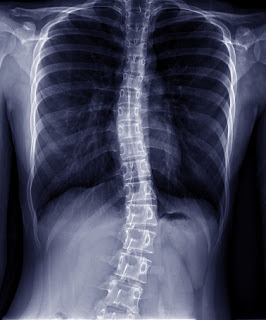All You Need To Know About Scoliosis
Spinal Cord is made up of small bones called vertebrae that are stacked on top of each other. It also has a natural curve that helps you bend and move. When you have scoliosis, your spine curves more than it should. It forms a "C" or "S" shape. The condition is often diagnosed during the first seven years of a child’s life.
Category
The largest category of scoliosis is idiopathic scoliosis, a term used to refer to cases that have no definite cause.
Idiopathic scoliosis is broken down by age group:
Infant: 0 to 3 years
Juvenile: 4 to 10 years
Adolescent: 11 to 18 years
Adult: 18+ years
Adolescent idiopathic scoliosis is the most common.
Types
Doctors identify a cause for an estimated 20 percent of scoliosis cases. These consist of different types of scoliosis, including:
congenital, in which spinal deformities are apparent at birth
neurological, when nerve abnormalities affect muscles in the spine
Scoliosis can also be categorized as either structural or nonstructural. In structural scoliosis, the spine’s curve is caused by a disease, injury, or birth defect, and is permanent. Nonstructural scoliosis describes temporary curves that can be fixed.
Signs
back pain is the first sign of scoliosis in adults. The pain may be from bone damage in the back -- not the scoliosis itself. As the spine curves, it can put pressure on nearby nerves and cause symptoms like weakness and numbness.
Signs of Scoliosis is like these:
Uneven shoulders and/or hips
Bump in the lower back
Numbness, weakness, or pain in the legs
Trouble walking
Trouble standing up straight
Tired feeling
Shortness of breath
Loss of height
Bone spurs -- bony bumps in the joints of the spine from bone and joint damage
Feeling full quickly while you eat. This is because your spine is putting pressure on your belly.
The best way to treat pain caused by scoliosis is to treat the scoliosis. Depending on the type of pain, there are various pain treatments available to you.
Complementary therapies
Options in this category include:
hydrotherapy and massage
exercise that strengthens your stomach and back muscles, such as Pilats, yoga, swimming, and stretching, which can also help relieve back pain
certain types of braces to support the spine
Medication
Over-the-counter medicines like acetaminophen (Tylenol) and ibuprofen (Advil) may help relieve pain. Talk to your doctor if these medications don’t work. They may prescribe stronger pain medication or refer you to a pain clinic.
Some antidepressants can also be used to relieve pain because they have a direct effect on pain in addition to mood.
Chiropractic treatment
Chiropractic treatment may be considered to help decrease pain and increase flexibility. Note that this kind of treatment won’t cure scoliosis but can help alleviate symptoms of pain.
Though research is limited, an older studyTrusted Source suggested that people with scoliosis reported improvements in pain and other symptoms immediately after chiropractic treatment and also 24 months later.
It’s important to find a chiropractor with a specialty in scoliosis. Those who aren’t specialists have the potential to make the condition worse.
Counseling
Your doctor may refer you to a counselor. Counseling may be helpful for chronic pain, especially when medical treatments aren’t managing pain well.
One type of counseling is called cognitive behavioral therapy (CBT). CBT won’t change the amount of pain you feel, but it can help you find ways to cope with it.
A CBT counselor will talk to you about how you manage your pain. The counselor can also help you to develop techniques for dealing with pain.
Spinal injections
Injecting steroids around the nerves and spinal joints can help ease pain. However, injections don’t have a long-term benefit. They can be used to combat acute pain or as one part of a pain management program.
Peripheral nerve stimulation
A transcutaneous electrical nerve stimulus device may be helpful for people who are experiencing pain caused by damaged nerves. In this treatment, electrical wires use mild electrical currents on the peripheral nerves near the spinal cord.
Go to your doctor if you notice signs or symptoms of scoliosis. Mild curves, however, can develop without the parent or child knowing it because they appear gradually and usually don’t cause pain. A physical exam of your spine is the first step your doctor takes to see if you have scoliosis. Your doctor may also order some imaging tests to get a closer look at your spine.




Comments
Post a Comment